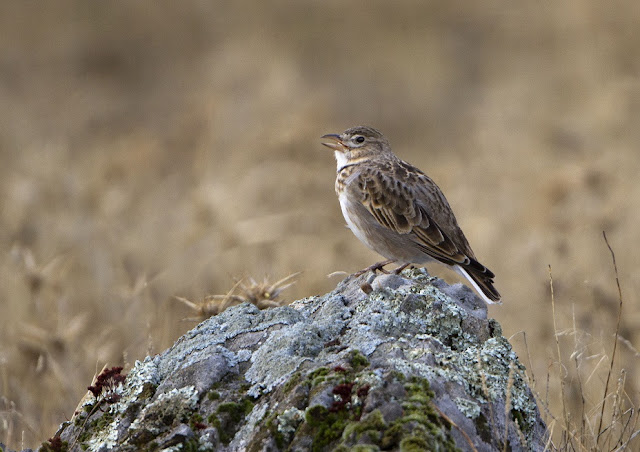 |
| Calandra Lark forms large post-breeding flocks in the summer (John Hawkins) |
The summer heat has been fiercer and more prolonged this year, pushing folk indoors for most of the day as temperatures hit 40ºC, thus the exhilaration to be out in the relative freshness of dawn. It was especially so this morning following a night of distant thunder, with the emerging rays of sunshine blushing the pink-grey clouds. On the plains the spring mosaic has been transformed to an almost monochrome blonded-yellow with pasture now indistinguishable from cereal stubble. The only fields that stand apart are those that have been ploughed and now rest. In one, where the ground had been turned over months ago, there was an incongruous green: the indomitable Heliotrope with its rounded grey-green leaves and tiny furl of white flowers, a plant that somehow flourishes in bare dry soils and the dessicating heat of high summer.
The first birds airbourne were the parties of Cattle Egrets, radiating purposefully from the roost, quickly followed by the Black Kites with lazy flight, drifting. Atop piles of stones in the fields, rock-coloured in the dawn light, but distinctive in form, were Little Owls - from one stop I could see four different individuals. From the same spot, I picked out the periscope-shaped necks and heads of Great Bustard, in a meadow of dry grass so tall that they were almost hidden. White Storks were also out patrolling the ground for grasshoppers. A wave of short sharp notes filled the air, just like the sound of dry broom seed pods bursting open in the sun, as a group of Corn Buntings passed me. Birds seemed to be in flocks. A party of a hundred Spotless Starlings were lined-up, in regimented fashion, on the fence, a mixture of blackish adults and browner juveniles. They swirled down to the meadow and disappeared completely from view in the grass. From stubble rose a rasping, wheezing mass of Calandra Larks, with Short-toed Larks accompanying them, emerging in waves and then flying noisily in low direct flight to settle again, successive groups leap-frogging others. There must have been six or seven hundred of them, and as they turned to settle the flash revealed of white outer tail feathers and traling edge to the wing.
 |
| The monochrome plains of high summer (Martin Kelsey) |
Seemingly nearby a Quail sang, but so deceptive is the sound and featureless the grassy terrain, that I did not attempt to even guess its whereabouts as I set off on a short walk across the field, in the opposite direction. As I did so, a spring-loaded Quail catapaulted from the ground a few feet away and zoomed off just above the vegetation before banking sharply, landing and disppearing. It was a different individual from the singing bird and had taken me by surprise. I stood still. Sightings of this widespread bird are rare and they are very hard to flush. I have occasionally seen competing males, coming out onto open ground in rivalry and with careful forward-thinking, Quail can sometimes be spotted as one looks far enough ahead along dirt tracks, especially when they come out of the verge at dawn to grit. But most of my sightings have been in autumn and winter when Quail more easily take to flight from the stubble in the rice fields. It was whilst talking about Quails that my friend Mark Cocker reminded me that the Spanish name
Guión de Codornices (meaning "the Quails' guide or herald") is given to the Corncrake, whose French name has a similar connotation. Hunters of old had noted that on migration the two species were often associated. Indeed almost all of the handful of Corncrake records from Extremadura are of birds mistaken for Quail and shot during the short autumn Quail-hunting season (I say
mistaken deliberately since the hunters handed the birds to the authorities because they could not identify them and had taken them for Quail as they flew up). No ornithologist has any idea how many Corncrake regularly migrate through Extremadura and I know of none who has seen one alive here. Therein the challenge!





Comments